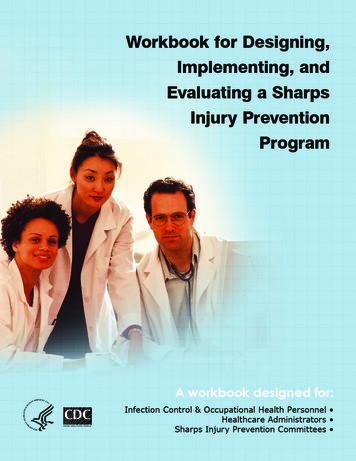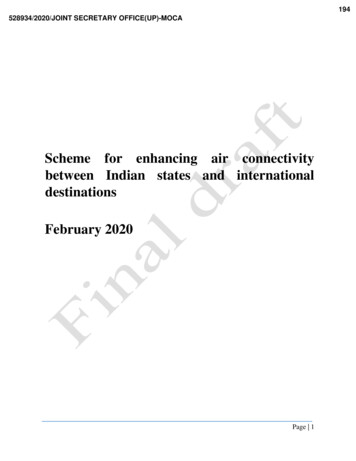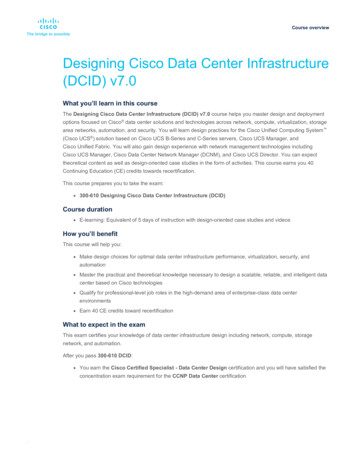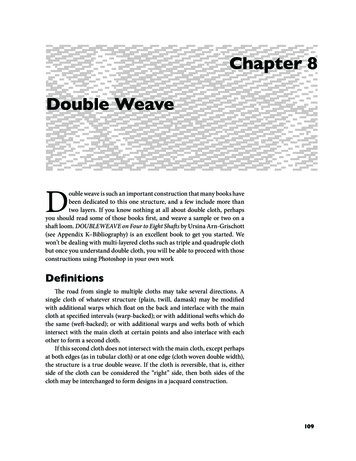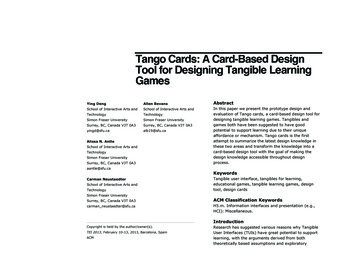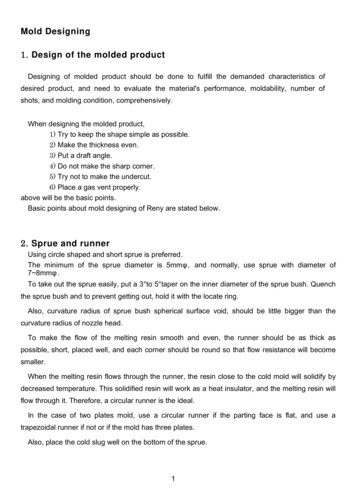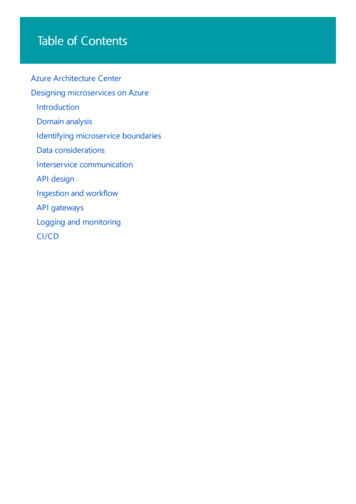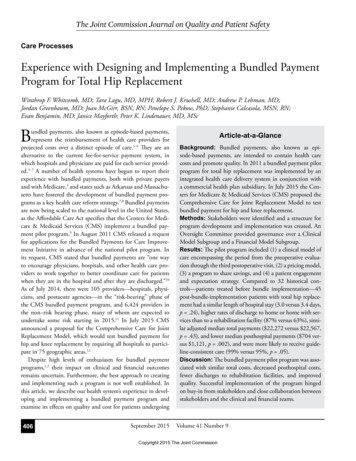
Transcription
The Joint Commission Journal on Quality and Patient SafetyCare ProcessesExperience with Designing and Implementing a Bundled PaymentProgram for Total Hip ReplacementWinthrop F. Whitcomb, MD; Tara Lagu, MD, MPH; Robert J. Krushell, MD; Andrew P. Lehman, MD;Jordan Greenbaum, MD; Joan McGirr, BSN, RN; Penelope S. Pekow, PhD; Stephanie Calcasola, MSN, RN;Evan Benjamin, MD; Janice Mayforth; Peter K. Lindenauer, MD, MScBundled payments, also known as episode-based payments,represent the reimbursement of health care providers forprojected costs over a distinct episode of care.1–4 They are analternative to the current fee-for-service payment system, inwhich hospitals and physicians are paid for each service provided.5–7 A number of health systems have begun to report theirexperience with bundled payments, both with private payersand with Medicare,3 and states such as Arkansas and Massachusetts have fostered the development of bundled payment programs as a key health care reform strategy.7,8 Bundled paymentsare now being scaled to the national level in the United States,as the Affordable Care Act specifies that the Centers for Medicare & Medicaid Services (CMS) implement a bundled payment pilot program.9 In August 2011 CMS released a requestfor applications for the Bundled Payments for Care Improvement Initiative in advance of the national pilot program. Inits request, CMS stated that bundled payments are “one wayto encourage physicians, hospitals, and other health care providers to work together to better coordinate care for patientswhen they are in the hospital and after they are discharged.”10As of July 2014, there were 105 providers—hospitals, physicians, and postacute agencies—in the “risk-bearing” phase ofthe CMS bundled payment program, and 6,424 providers inthe non–risk bearing phase, many of whom are expected toundertake some risk starting in 2015.11 In July 2015 CMSannounced a proposal for the Comprehensive Care for JointReplacement Model, which would test bundled payment forhip and knee replacement by requiring all hospitals to participate in 75 geographic areas.12Despite high levels of enthusiasm for bundled paymentprograms,1,2 their impact on clinical and financial outcomesremains uncertain. Furthermore, the best approach to creatingand implementing such a program is not well established. Inthis article, we describe our health system’s experience in developing and implementing a bundled payment program andexamine its effects on quality and cost for patients under going406September 2015Article-at-a-GlanceBackground: Bundled payments, also known as epi-sode-based payments, are intended to contain health carecosts and promote quality. In 2011 a bundled payment pilotprogram for total hip replacement was implemented by anintegrated health care delivery system in conjunction witha commercial health plan subsidiary. In July 2015 the Centers for Medicare & Medicaid Services (CMS) proposed theComprehensive Care for Joint Replacement Model to testbundled payment for hip and knee replacement.Methods: Stakeholders were identified and a structure forprogram development and implementation was created. AnOversight Committee provided governance over a ClinicalModel Subgroup and a Financial Model Subgroup.Results: The pilot program included (1) a clinical model ofcare encompassing the period from the preoperative evaluation through the third postoperative visit, (2) a pricing model,(3) a program to share savings, and (4) a patient engagementand expectation strategy. Compared to 32 historical controls—patients treated before bundle implementation—45post-bundle-implementation patients with total hip replacement had a similar length of hospital stay (3.0 versus 3.4 days,p .24), higher rates of discharge to home or home with services than to a rehabilitation facility (87% versus 63%), similar adjusted median total payments ( 22,272 versus 22,567,p .43), and lower median posthospital payments ( 704 versus 1,121, p .002), and were more likely to receive guideline-consistent care (99% versus 95%, p .05).Discussion: The bundled payment pilot program was associated with similar total costs, decreased posthospital costs,fewer discharges to rehabilitation facilities, and improvedquality. Successful implementation of the program hingedon buy-in from stakeholders and close collaboration betweenstakeholders and the clinical and financial teams.Volume 41 Number 9Copyright 2015 The Joint Commission
The Joint Commission Journal on Quality and Patient Safetytotal hip replacement. In addition to reporting our results, wealso hope to assist organizations that might consider developingbundled payment programs for their patients.ical director and laboratory contractual relationships, but noownership or formal affiliation, between Baystate Health andthe main referral skilled nursing facility.MethodsSetting and ParticipantsDevelopment of the Clinical ModelOn January 1, 2011, Baystate Health, an integrated healthcare delivery system in western Massachusetts, commenced atotal hip replacement bundled payment program with an independent group of orthopedic surgeons from Springfield (NewEngland Orthopedic Surgeons). Before program development,the leadership of Baystate Health identified the establishment ofbundled payment programs as an organizational strategic goal.The aim of the program was to develop a model process for creating and implementing bundled payments and to test whethersuch an approach for total hip replacement could lower costswhile maintaining or improving quality.We identified primary stakeholders and included them asparticipants in the program, including New England Orthopedic Surgeons and three affiliates of Baystate Health—Baystate Medical Center (the single hospital where the study wasconducted), Health New England (a provider-sponsored healthplan), and Baystate Visiting Nurse Association and Hospice. InMay 2010 we convened an Oversight Committee representing the participating groups to develop the bundled paymentprogram for total hip replacement. The Oversight Committee, which consisted of approximately 10 members [includingW.F.W, R.J.K., A.P.L., S.C., E.B., J.M.*], provided governanceover two distinct subgroups, each consisting of approximatelysix members, as follows:1. The Clinical Model Subgroup [including W.F.W., R.J.K.,A.P.L., J.G., S.C., J.M.] , which focused on developing the clinical elements of the bundle2. The Financial Model Subgroup [including W.F.W., S.C.,J.M.], which generated a price for the bundle (see the description of the reimbursement model, page 409).After seven months of coordinated planning between thesegroups, the bundled payment pilot began on January 1, 2011,and continued through December 31, 2011. The Baystate Medical Center Institutional Review Board approved this evaluationwith a waiver of informed consent.Before the bundle period, New England Orthopedic Surgeons held a medical directorship with a stipend for the totaljoint replacement orthopedic service line at Baystate MedicalCenter. This arrangement did not change during the bundleperiod. Before and during the bundle program, there were med*J.M., Janice Mayforth.September 2015The Clinical Model Subgroup of the Oversight Committee was responsible for developing the elements of clinical carefor the time period encompassed by the bundled payment. Thesubgroup based the clinical model on evidence and/or consensus, drawing on previous work accomplished in the organization, national quality measures, and modifications based ongoals for the program.1 We created an order set in the hospitalelectronic health record to ensure adherence to the intendedtreatment plan.Development of the Financial ModelThe Financial Model Subgroup was tasked with establishingthe component parts of the bundled payment program, generating a price for the bundle, and distributing savings. This subgroupbegan by examining all payments made by the health plan to theprovider entities (for example, physicians, radiology, pharmacy,durable medical equipment, hospital, Visiting Nurse Association, rehabilitation facility, ambulance) for the diagnosis codescorresponding to total hip replacement. Then, in coordinationwith the Clinical Model Subgroup, it narrowed down the elements to be included in the bundle. After the bundle components were established, this subgroup sought to derive an overallprice for the bundle, representing the sum of the components.OutcomesQuality of care was measured using established nationalmetrics in the domains of care processes, harm, mortality, and30-day readmissions. We obtained surgical quality metrics fromdata routinely collected for quality improvement pur poses,13including Surgical Care Improvement Project measures, rele vant Agency for Healthcare Research and Quality (AHRQ)Patient Safety Indicators,14 and CMS Hospital-Acquired Conditions.15 We extracted data on length of stay (LOS) from Baystate Health’s billing software. We obtained data on hospitalpayments, physician payments, posthospital payments, andtotal payment directly from the payer, Health New England. Ofnote, there was a change in the diagnosis-related group (DRG)payment method just before the start of the bundle period.Moreover, the patients included were insured by Health NewEngland in any of three payment groups. Payments includeda DRG base payment (defined for each payment plan) multiplied by a DRG weight. Because both the DRG base amountsVolume 41 Number 9Copyright 2015 The Joint Commission407
The Joint Commission Journal on Quality and Patient SafetySidebar 1. Elements of the Bundled Payment ProgramServices and Procedures Included in the Bundled PaymentPayment to orthopedic surgeon for procedure(includes one postoperative visit)Surgeon preoperative and two postoperative visitsPlain x-ray at each surgeon visitPreoperative education classPreoperative physical therapy visitAcute care hospitalization, including surgical procedureAmbulance transport from hospital to nursing facilitySkilled nursing facility rehabilitationOutpatient physical therapyOutpatient occupational therapyServices and Procedures Excluded from the Bundled PaymentNonorthopedic surgeon physician feesOutpatient drugsDurable medical equipmentAll other postacute servicesand the DRG weight changed for all three patient groups, weadjusted hospital payments for each patient in the baseline (prebundle) period, using the DRG base and weights from the bundle period. This would “adjust down” the baseline payments,removing the effect of DRG changes and allowing comparisonof payments between pre- and bundle periods.Data AnalysisWe compared patient characteristics and outcomes for pa tients during the bundle period (calendar year 2011) to patientstreated in the year before implementation of the bundle (2010)using chi-square test, Fisher’s exact test for categorical factors,and Wilcoxon rank-sum test for age, LOS, and payments.ResultsOversight CommitteeGiven the complexity of the program, the Oversight Committee believed that using the simplest and narrowest definition ofbundle components would increase the bundle’s chances for success. Our approach to the structure of the bundle, therefore, wasto limit inclusion to services that were directly related to theprocedure itself and that could favorably influence costs undera shared savings model (Sidebar 1, above). For example, for services provided by the orthopedic surgery practice, a preoperativevisit with a plain x-ray, and three postoperative visits (each with aplain x-ray if indicated) were included. For posthospital services,skilled nursing facility rehabilitation, outpatient physical therapy, and visiting nurse visits were included. We provided clearguidelines as to the duration and intensity of the posthospitalservices, with the goal of eliminating services (such as prolongednursing facility stays) for which there was no evidence of benefit.408September 2015Clinical ModelThe bundle was initiated after the surgeon had identified theneed for a total hip replacement. We chose to define bundleduration according to the period of services in support of theepisode instead of a discrete time period (for example, 90 days)to allow the providers and patients more flexibility. The ClinicalModel Subgroup specified bundle components, beginning withthe orthopedist’s preoperative history and physical, and concluding with the third postoperative office follow-up visit. If thepatient progressed well postoperatively, the program aimed forhospital discharge two days after surgery. The final service provided—the third postoperative visit—was generally scheduledfor approximately 10–14 weeks after the date of surgery. Thesubgroup elected not to include the purchase of durable medical equipment, such as a walker, in the bundle because somepatients obtained it before admission, while others received itin hospital or after discharge, making costs difficult to captureand align with pricing. We did not provide a bundle warranty.The health plan, which is owned by the health system, would beresponsible for the costs of postoperative complications, such asa surgical site infection.The Clinical Model Subgroup determined that dischargingappropriate patients directly to home instead of to a rehabilitation facility represented an opportunity for cost savings andquality improvement. Accordingly, patients were educated aboutthe benefits of discharge directly to home (educational materials were updated accordingly), and it was agreed that the program would furnish extra home physical therapy services (asdescribed on page 409) for patients discharged directly to home.The main changes to the model of care during the bundle period, therefore, included aiming to discharge a subset of rapidlyprogressing patients after two hospital days (instead of the usualthree days) and to provide interventions to discharge patientsdirectly to home if appropriate. The hospital team—physician,case manager, physical therapist, nurse—collaborated to provide consistent messaging to patients regarding the plan for ahome discharge.An effort was made to schedule the surgery early in the day,with the goal of beginning physical therapy on the afternoonof surgery and discharging the patient two or three days aftersurgery. The model specified hospital care elements, includingvital signs, wound care, pain control, perioperative antibiotics,venous thromboembolism prophylaxis, physical/occupationaltherapy, patient teaching, and medication reconciliation. Afterthe patient was ready for discharge, published appropriatenesscriteria were used to determine whether he or she would gohome or to a facility,16 as follows:Volume 41 Number 9Copyright 2015 The Joint Commission
The Joint Commission Journal on Quality and Patient SafetyModel of Care from the Time of Patient Identification Through the End of the EpisodePrimary care orself-referral tosurgeonPreoperative visitwith surgeon within30 days of admitPreoperativeclassAdmission to hospitalfor surgerySurgeon visitPlan/BookBook as first case onMonday or TuesdaySame-dayrehab/education visitOut-of-area homecare provider followsrehab protocolNoDoes patient livein visiting nurse’sservice area?YesHome Care8 rehab visits–2-day hospital stay;6 rehab visits–3-day hospital stayYesDischargehome?NoYesPostoperativevisit with surgeon10–14 days w/x-rayNursingFacilityx 6 therapydaysNeedadditionalrehab?NoHomeYesHome care3–4 rehabvisitsOffice visit4–6 weeks w/x-rayOffice visit10–14 weeks w/x-rayFigure 1. Preoperative preparation included education, scheduling, surgeon visit, and rehabilitation evaluation. Posthospital physical therapy duration andfrequency with home care, which varied according to hospital length of stay, and skilled nursing facility were specified, as were three posthospital surgeon visits,after which the episode concluded. Rehab, rehabilitation. If the patient was discharged home two days after surgery,the model called for eight home physical therapy visits. For discharge home three days after surgery, six homephysical therapy visits were included. For discharge first to a rehabilitation facility, four homephysical therapy visits after facility discharge were included.As can be seen from the criteria, the care model during thebundle period was prescriptive as to the number of posthospitalskilled nursing days and duration of physical therapy, includingspecifying number of home therapy visits on the basis of hospital LOS and whether the patient had a stay in a skilled nursingfacility (Figure 1, above).Financial ModelThe program’s main goal was to provide an incentive to thephysicians and the hospital to provide efficient care such thatthese parties would share any savings realized through costsincurred below the target bundle price. The program was structured to allow a fee-for-service payment with an end-of-the-yearfinancial reconciliation that compared the actual costs of thebundle price to anticipated costs. If there were funds left over asa result of lower actual costs compared to the bundle price, theywould be placed into a shared savings pool. We opted for thisretrospective approach because of challenges associated withchanging the payment structure for a relatively small subset ofSeptember 2015all patients receiving total hip replacement.Because the program was structured as a pilot, there was alsono financial risk to the participating provider entities, includingthe orthopedic surgeons and the hospital, if costs were higher than projected. Initial formulations of the program specifiedthat savings be shared equally between the physicians and hospital. The Financial Model Subgroup decided on equal sharing of savings between the parties to recognize the partnershipbetween the two, in which each partner’s role in achieving theprogram’s goals is of equal importance. After discussion, theprogram sought to align incentives more closely with the Visit ing Nurse Association, so that in the final determination theywere also included in the shared savings. The shared savingsscheme allotted funds as follows: 45% to the physicians, 45% tothe hospital, and 10% to the Visiting Nurse Association. Notably, the Financial Model Subgroup did not work on contractingactivities to lower the cost of hip implants, as is common forsome bundled payment programs, because such work had beencompleted before program development. Therefore, the cost ofthe implants was the same before and during the bundle period.Patient EligibilityThe Clinical Model Subgroup established that all HealthNew England patients determined to be eligible for total hipreplacement would be included in the bundled payment proVolume 41 Number 9Copyright 2015 The Joint Commission409
The Joint Commission Journal on Quality and Patient Safetygram. This subgroup also performed the function of reviewingcases that had an unfavorable outcome in terms of quality orcost to determine if the patient should be excluded from thebundle program. In general, if the outcome was deemed attributable to an avoidable cause on the basis of the care model andbest practice, the patient was included. For example, if a complication was determined to have occurred as a result of failureto follow Surgical Care Improvement Project elements or to reconcile medications, the patient would be included in the program. If the Clinical Model Subgroup determined that the outcome was unavoidable or unrelated to the bundle, the patientwas considered for exclusion. Our goal was to avoid penalizingthe physicians, other providers, and the hospital for outcomesthat were out of their control. During the bundle period, therewas a single patient who was excluded. She was not compliantwith her psychiatric medication regimen prior to surgery andhad a prolonged postoperative inpatient stay as a result.Patient ActivationWe modified existing educational materials to address education and engagement regarding early hospital discharge. Whenappropriate, we discharged patients directly to home with therapy and services instead of transfer to a facility for rehabilitation, using published appropriateness criteria as a guide forphysical therapists and physicians. A patient compact was created to make explicit that the patient take responsibility for doingrehabilitation, taking medications, following up with his or herphysician, and generally being an active participant in the planof care. Along with the compact was an education program thatwas provided both during the preoperative history and physical with the orthopedist and also in a session at the hospital.The education focused on patient issues specific to the total hipreplacement procedure and subsequent recovery.Patient activation through incentives was considered. TheFi nan cial Model Subgroup discussed creating financial incentives, such as lower copays, for patients in the program (for example, for a home discharge), but given the small size of the pilotsample, decided against it because of administrative challenges.Pilot ResultsWe included 45 patients who underwent elective total hipreplacement during the bundled payment pilot between January and December 2011. Of these patients, almost half (22[49%]) were male and most (44 [98%]) were white, and themedian age was 55 years (Table 1, page 411). Bundle patientswere compared to 32 elective total hip replacement patientstreated from January 2009 through April 2010 who had very410September 2015similar demographic characteristics. There was no statisticallysignificant difference between groups in rate of obesity or combined comorbidity score.Compared to patients treated in the baseline period, thosetreated during the bundled payment pilot were more likely tobe discharged directly to home rather than to a rehabilitationfacility (63% versus 87% discharged home, p .03). MeanLOS decreased from 3.4 days in the baseline period to 3.0 daysduring the pilot (p .24). There was an improvement in adherence to a composite of the Surgical Care Improvement Projectprocess measures (95% to 99%; p .05, Table 2, page 412). Inthe baseline and bundle periods, there were no readmissions at30 days, no deaths, and no identified episodes of surgical siteinfection, urinary tract infection, complications of anesthesia,or postoperative sepsis.The median total cost per case decreased from 26,412during the baseline period to 22,567 during the bundle period(p .0001). After adjustment for changes in DRG weight thatoccurred January 1, 2011, for all Health New England patients,however, the adjusted median cost per case did not show a significant change, as it was 22,272 during the baseline period and 22,567 during the bundle pilot (p .43). A decreasein the median total hospital payment of 3,000 was primarily explained by the decrease in the payment related to changes in the DRG—an adjustment that caused hospital paymentsto appear as if they had increased by 1,000. There were statistically significant lower payments to the physicians ( 2,736in the baseline period versus 2,541 in the postbundle period,p .001). When we analyzed postacute care costs, we also ob served a significant decrease (baseline period, median 1,121versus postbundle, 704, p .002).DiscussionWe have described the development, implementation, and earlyphase results of a bundled payment program for total hip replace ment that was associated with similar total costs, lower posthospital costs, shorter LOS, and similar or higher quality of care inthe hospital. The program was carried out within the context ofan integrated health care delivery system with a hospital, a provider-sponsored health plan, a visiting nurse association, and anindependent group of orthopedic surgeons. Lower posthospitalcosts realized for the bundle program were derived almost exclusively from decreased utilization of skilled nursing facilities.In contrast to a previous report on bundled payments, whichincluded employed physicians, this program had the participation of an independent, nonemployed physician group.3 Animportant factor in the implementation of the bundle programVolume 41 Number 9Copyright 2015 The Joint Commission
The Joint Commission Journal on Quality and Patient SafetyTable 1. Characteristics and Outcomes for Total-Hip-Replacement Patients,Baseline (2010) and Bundle (2011) PeriodsBaseline Period (N 32)n (%) or Median [IQR]Bundle Period (N 45)n (%) or Median [IQR]P ValueAge58.5 [55–62]55 [51–60].24*Male16 (50)22 (49).92†White31 (97)44 (98).66‡Principal Diagnosis: 715.35 Osteoarthrosis,localized NOS Pelvis23 (72)43 (96).006‡Gagne Comorbidity Score0 (0–2)0 (0–1).15*Obese5 (16)3 (7).27‡113 (41)15 (33)213 (41)22 (49)36 (19)0 (0)40 (0)8 (18)Patient CharacteristicsSurgeonDRG Rate Group.0011‡.08‡Baystate Health Employee Group10 (31)5 (11)HMO/PPO19 (59)36 (80)3 (9)4 (9)LOS (Mean SD)3.4 (1.6)3.0 (0).24§LOS3 [2–12]3 [3–4].24*SelectOutcomesDischarge to:Home, self-careHome health services2 (6)1 (2)20 (63)39 (87).032‡Skilled nursing/rehab10 (31)5 (11)Facility Total Payment ( )26,412 (25,769–28,184)22,567 (22,284–23,029).0001*Total Payment, adjusted for DRG change ( )22,272 (21,629–24,148)22,567 (22,284–23,029).43Payment Breakdown ( )2,736 (2,680–2,809)2,541 (2,489–2,729).0011*Hospital PaymentPhysician Payment22,043 (22,008–23,240)19,101 (19,101–19,612) .0001*Hospital Payment adjusted for DRG change18,007 (17,868–19,100)19,101 (19,101–19,612) .0001*1,121 (728–3,619)704 (575–840).0018*Posthospital PaymentIQR, interquartile range; NOS, not otherwise specified; DRG, diagnosis-related group; HMO, health maintenance organization; PPO, preferred provider organization;LOS, length of stay; SD, standard deviation; rehab, rehabilitation.* Wilcoxon rank-sum test.† Chi-square test.‡ Fisher’s exact test.§ t-test.was that the physician group had an established track record ofprogrammatic development with the hospital, including bestpractice protocols and team-based care. Our bundle programwas designed to be simple, both in terms of the elements of thebundle and the mechanism by which savings were distributed,and selective, in that it included a portion of posthospital costs.September 2015The providers were deemed appropriate for receipt of a portion of savings as long as performance on quality measures wasmaintained at or above baseline levels. The structure of the program enabled us to make continuous efforts to include physicians, physical therapists, case managers, and administrators indesigning and implementing the bundle to ensure buy-in andVolume 41 Number 9Copyright 2015 The Joint Commission411
The Joint Commission Journal on Quality and Patient SafetyTable 2. Surgical Care Improvement Project Scoresfor Total-Hip-Replacement Patients,Baseline (2010) and Bundle (2011) PeriodsBaselinePeriod(2010; N 32)Performance MeasureBundle Period(2011; N 45)n (%)n (%)P ValueAppropriate antibioticselection29 (91)45 (100).068Antibiotics discontinuedwithin 24 hours30 (94)45 (100).170Appropriate hairremoval32 (100)45 (100)--Beta blocker continuedthrough perioperativeperiod4/4 (100)7/8 (88)1.00027 (84)44 (98).076.95 (0.02).99 (0.01).052*Appropriate Care “All or none”Composite (mean, SE)measure numerator/measure denominatorSE, standard error.*p-value from t-test; all others from Fisher’s Exact Test.commitment to the success of the program.Our experience should be interpreted in the context of prior work. The findings of a recent report tempered enthusiasmfor bundled payments in the commercial sector. The studydescribed a multipayer, multiprovider initiative in Californiathat provided bundled payment for orthopedic procedures forpatients younger than 65 years of age.17,18 Providers in this pilotprogram were at full risk for orthopedic bundles, including a90-day warranty period. However, the initiative failed to enrolla sufficient number of patients for evaluators to assess qualityand cost of care under bundled payments, with just 35 patientsin participating hospitals and 111 patients in ambulatory surgery centers. This occurred because the pilot program encountered a number of barriers; for example, it attempted to use aretrospective payment reconciled against the target bundle ratebut encountered substantial administrative burden related tothe manual administration of claims. There were also significant regulatory delays to contract approval. Notably, the orthopedic bundles in the pilot program did not include posthospitalservices (except physical therapy); it also had no risk-adjustmentor stop-loss features. The reported difficulty in implementingbundled payment echoed the earlier findings of the evaluationof the Prometheus Payment program.4,5We found that establishing the services and parametersregarding the bundle definition (Sidebar 1) was a key compo412September 2015nent of the success of the program. In addition, similar to thePrometheus pilot, we found that the committee structure (usingboth a clinical and finance team) and engaging stakeholdersearly on were important contributors to program implementation.4,5,17,18 It should also be noted, however, that it remainsunclear whether our pilot demonstrated significant overall costsavings. This is because the initiation of the pilot coincided witha change in the DRG weighting, which resulted in an averagereduction in payment of approximately 4,000 per patient. Forexample, real cost savings were observed, as in the decreases inpayments to physicians and postacute care costs. There were alsoactual decreases in the payment to the hospital (from 22,043to 19,101). However, because there was a concomitant changein the DRG, it was nearly impossible to know what proportion,if any, in the change in payments to the hospital was due to thebundle program. In an attempt to determine whether the bundle program had an impact, we adjusted the payments to reflectthe DRG weighting. The result was that although we observeddecreases in physician payments and postacute care, the apparent “increase” in the cost of hospital care negated th
Thfffiffifl ffi ffifl ffi ffiffiffififfifi S v n 407 total hip replacement. In addition to reporting our results, we also hope to assist organizations that might consider developing

